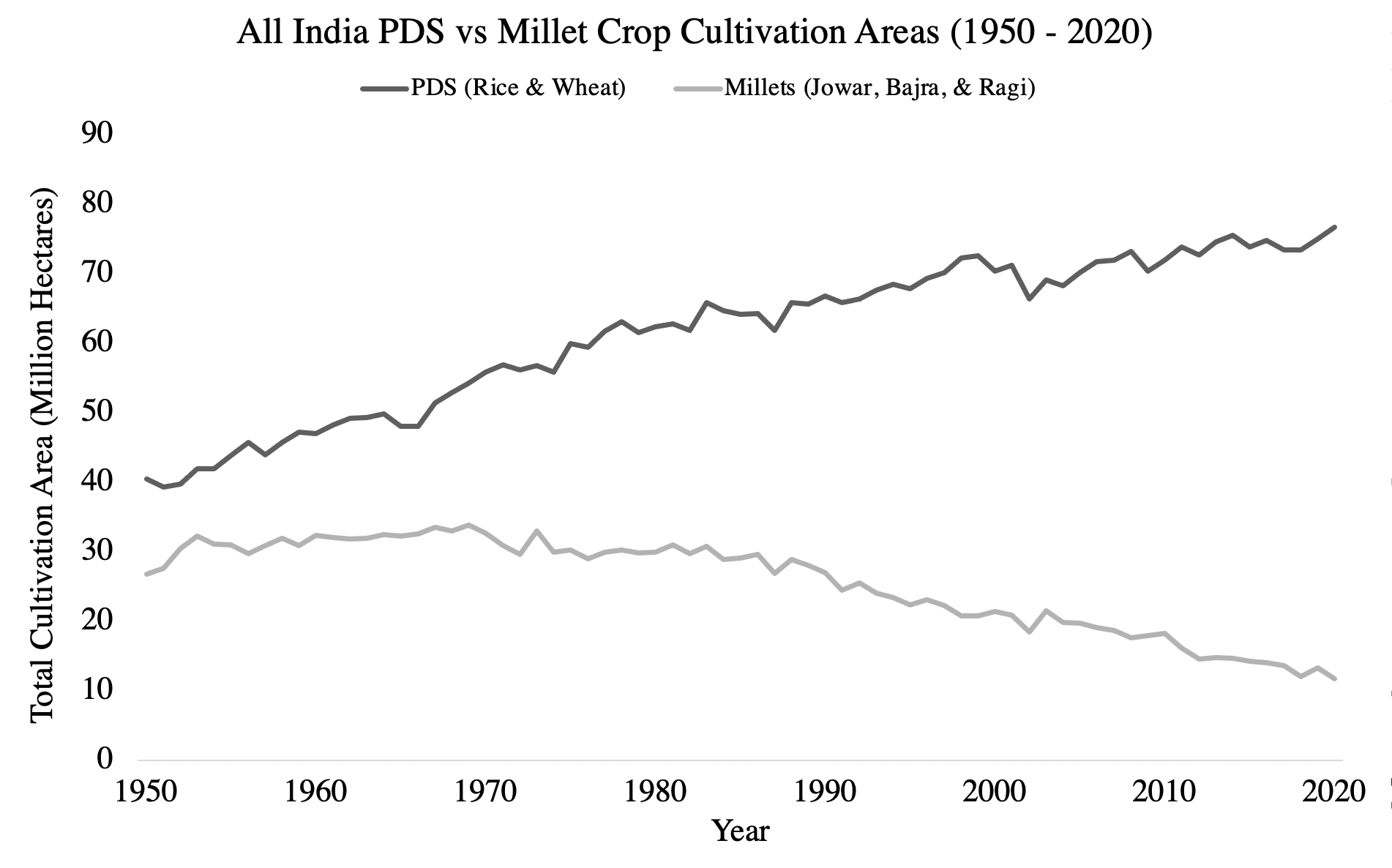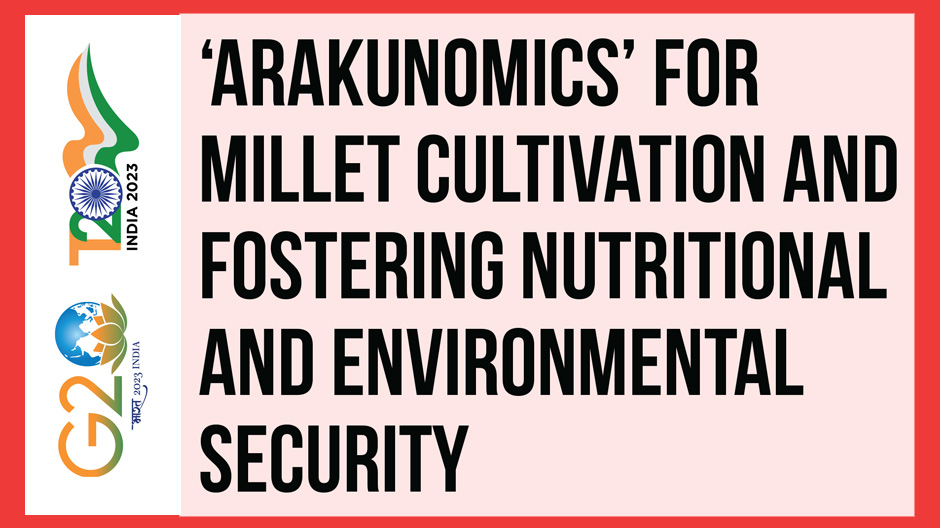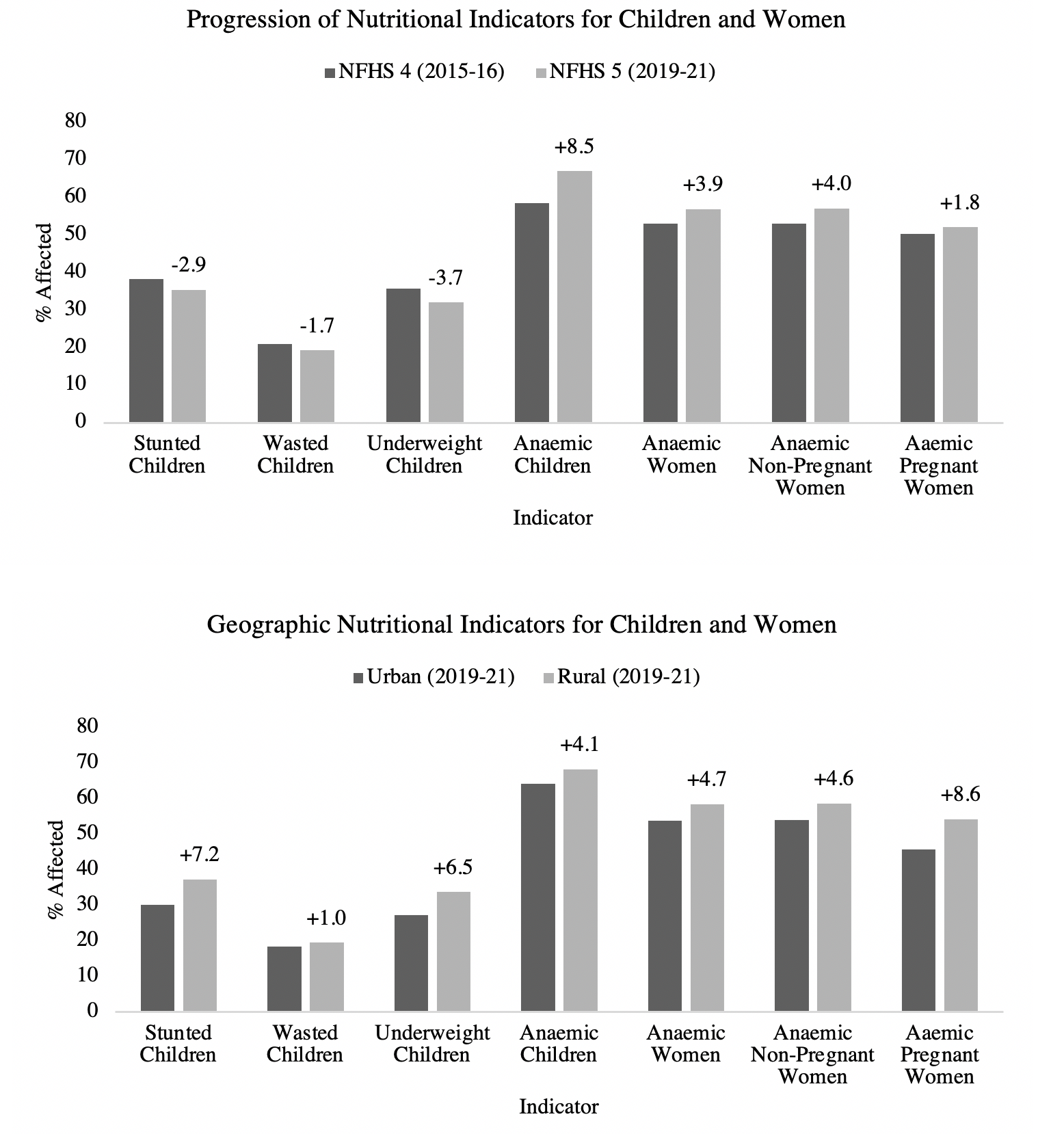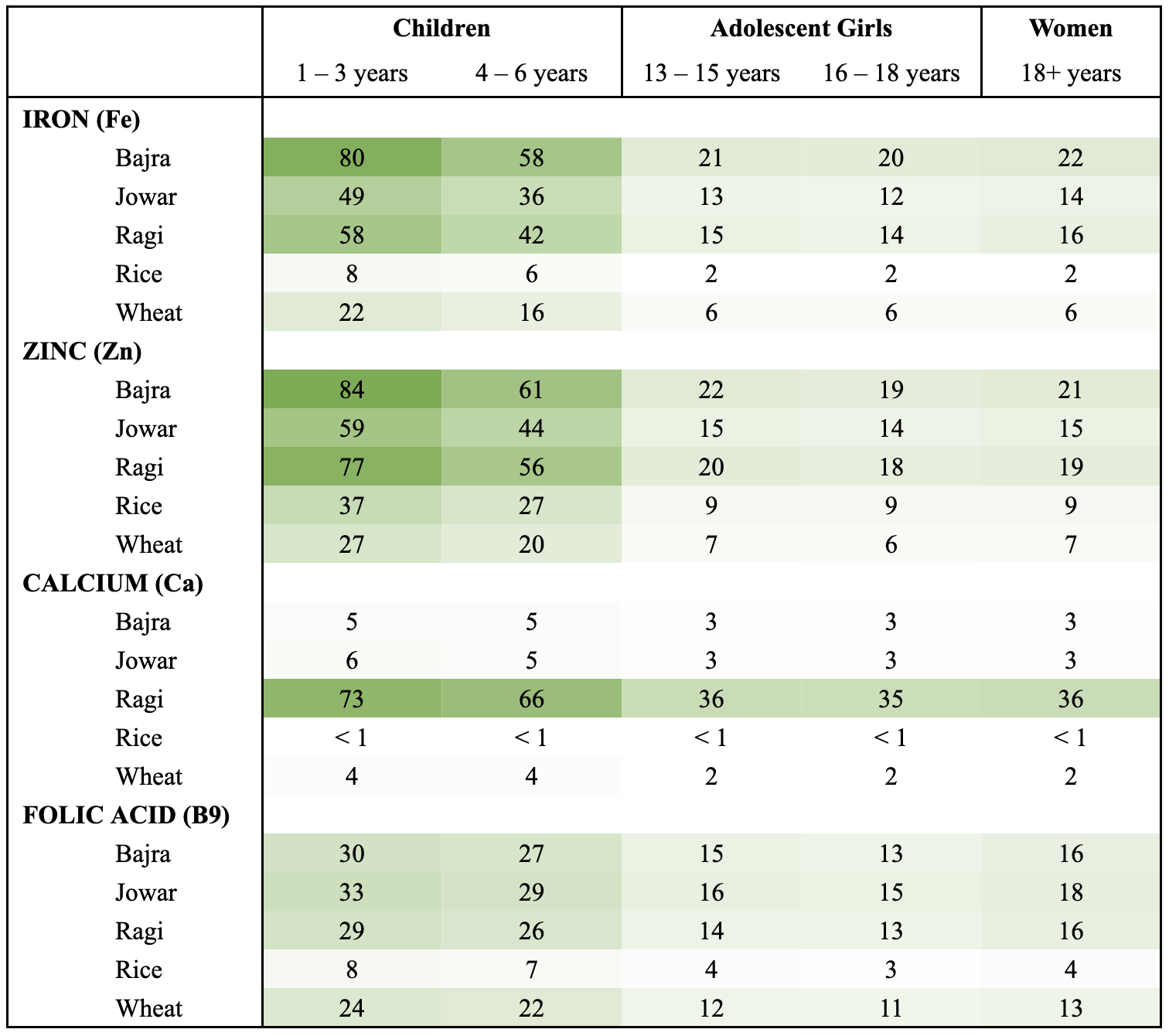Task Force 6: Accelerating SDGs: Exploring New Pathways to the 2030 Agenda
Malnourishment indicators amongst children, girls, and women reflect an intergenerational cycle of hidden hunger, likely due to an absence of nutritious and diverse diets. India’s National Food Security Act enshrines the statutory right to nutritional security and mandates the subsidised distribution of nutraceutical millets through the public distribution system. However, there has been a reduction in India’s millet acreage since the 1960s due to the crop’s stigmatic association with poor farmers and the lack of policy support compared to the primary minimum support price staples.[1] This policy brief recommends an integration of the ‘Arakunomics’ approach with public food systems to revive profitable millet cultivation and provide nutrition to consumers and soils, profits to farmers, and regeneration to ecosystems.
1. The Challenge
Nutritional Insecurity
Malnutrition of children and women in India is a pervasive public health issue underscored by lack of nutritious and diverse diets. Data from the National Family Health Survey (NFHS)-5 (2019-21) reveals widespread anaemia amongst children and women—specifically, 67.1 percent of children, 57.0 percent of all women, and 52.2 percent of pregnant women (see Figure 1).[2] Incidences of anaemia have steadily increased since 2015-16 by 8.5- and 3.9-point percentage for children and all women respectively.[3] A recent report on India’s district-level progress on fulfilling the Sustainable Development Goals (SDGs) claims that India “will never be able to meet SDG targets relating to anaemia,” given that 86 to 91 percent of the 707 investigated districts were categorised as off-target and without any capacity for reducing women’s anaemia to the target of 50 percent.[4]
The prevalence of malnourished children is inextricably linked to that of malnourished mothers. The former is confirmed in NFHS-5, as approximately a third of children are stunted (35.5 percent) and underweight (32.1 percent).[5] The Global Hunger Index (2022) stresses that India’s child wasting rate of 19.3 percent is highest in the world, and that a rate above 15 percent should be treated as a public health emergency requiring urgent policy reforms.[6] Furthermore, only 11.3 percent of children below the age of two receive an adequate diet of three meals a day comprising of at least four food groups.[7] During the first two years of life, the physiological, neurological, metabolic, and immune systems undergo rapid growth and development. Without sufficient nutrients, these systems will be gravely and irreversibly compromised in a way which perpetuates occurrences of physiological illness throughout life.[8] It is therefore of high concern that 9 out of 10 children are not adequately replenished during their most critical period of development Without sufficient nutrients, these systems will be gravely and irreversibly compromised in a way which perpetuates occurrences of physiological illness throughout life. It is therefore of high concern that 9 out of 10 children are not adequately replenished during their most critical period of development. Anthropometric and anaemic indicators of malnutrition for children and women are consistently higher in rural compared to urban areas (see Figure 1).
Figure 1: Malnutrition indicators for children (<5 years) and women (15-49 years) across NHFS surveys and urban-rural geographies
This is poignant for stunted and undernourished children and anaemic pregnant women, who show 7.2-, 6.5-, and 8.6-point percentage higher levels of occurrence in rural areas.[11] Furthermore, only the two highest wealth quintiles of rural households have sufficient income to afford the minimum cost of a healthy diet.[12] Restricted access to nutritious food, specifically in rural areas, underpins chronic malnourishment which causes 0.5 percent of India’s total deaths.[13] This reality calls for economic policies aimed at swiftly restoring rural India’s nutritional security.The National Food Security Act (NFSA) was established in 2013 to ameliorate financial restrictions to nutritious food for socioeconomically deprived groups.[14] The procurement and subsidised distribution of millets, specifically jowar, bajra, ragi, and other small millet varieties, were inscribed into this statutory reform with the hope of improving nutritional intake among children, women, pregnant women, and new mothers. Across 2022, the Public Distribution System (PDS) procured 2.1 crore tonnes of foodgrain for subsidised distribution to 46.5 crore beneficiaries.[15] Rice and wheat are the only grains to avail, as millets remain absent from the item lists of the majority of Fair Price Shops and PDS stocking silos.[16] The nutritional and environmental benefits of millets remain unrealised, as does food security. Innovative collaborations of agricultural and policy sectors are thus essential for reliable access to NFSA’s mandated nutritious and diverse food baskets.
Figure 2: PDS staples versus millet cultivation trends pan India between 1950 – 2020

Source: Ministry of Agriculture, Government of India.[17]
Environmental Insecurity
Despite the status of millets as an ancient, nutritious grain cultivated and consumed across India for millennia, they are becoming ‘bhoole bisre anaai’ (long forgotten grains) to farmers and consumers alike. Traditional knowledge of their preparation for meals and agricultural practices of their cultivation have decreased substantially over the years.[18],[19] This is due to the perceived advantages of cultivating wheat and paddy, such as assured minimum support price (MSP). The socio-agricultural shift away from nutritious millets towards starchy staples (see Figure 2) continues to shape the consequences for ecological integrity and population health.
Following the Green Revolution of the 1960s, the government adopted and maintained three production-centric policies in favour of newly introduced high-yield rice and wheat varieties:
- MSP remunerative purchasing;
- subsidies for urea and other fertilisers; and
- free electricity for irrigation
These policy pillars were designed to ensure profitable farming and affordable staples within the PDS framework. They are heralded as economically viable and scientifically optimised responses to the demand for sufficient foodgrain for vulnerable members of the fast-growing population. They are thus deeply entrenched within the Atmanirbhar Bharat narrative of India’s self-sufficient agrarian future.[20] Case studies on the environmental effects of this paradigm in states it is most intensively practised, however, highlight that it comes at a cost to fertility of soil,[21] cleanliness of air,[22] and availability of water.[23]
The Johl Committee report (2002) urged for diversification of Punjab’s cropping system, a primary source of India’s foodgrain, and the divergence of 20 percent of the state’s smallholding area to more nutritious and less-water intensive crops such as millets and pulses.[24] This reformation was deemed a precondition for Punjab (or any state) to avert an agrarian crisis, caused by water table extraction, air pollution, and soil desertification, and increase ecological resilience for nutritional security and economic prosperity of consumers and farmers. This recommendation is highly applicable in today’s socioeconomic and agricultural climate.
Addressing Insecurities with Arakunomics
The Johl Committee’s recommendations to increase access to nutritious foods through biodiverse and self-sufficient food networks is a prerequisite for any prosperous society which aspires towards biodiversity in farming, health for people, and profitability for farmers. Naandi’s insights from vulnerable agrarian societies with nutritional and ecological deprivation have revealed that restoration of livelihoods is possible when farmers and soils are prioritised and protected at all costs. Circular food economies thrive only when the farmer is fairly remunerated for her labour and produce, and when soil is reliably replenished with carbon and nutrients. To sustain this economy, profits and compost as literal and biological capital must be returned to farmers and the soil in abundance, as such currencies allow each entity to nourish themselves and continue their work. By acknowledging the true cost of food and ensuring that remunerations are appropriately made, Naandi developed Arakunomics as a transformative, sustainable food system which is nutritious, equitable, and efficient in its service to people and the environment.
Arakunomics can be described as an economic model of regenerative agriculture. It is a credible decentralised paradigm of cost-effective, scalable, and sustainable operations which support adoption of profitable, restorative, and biodiverse farming practices by small and marginal farmers and ensures their economic and nutritional security. When made affordable, accessible, and convenient via Regenerative Agricultural Hubs (RAHs), the knowledge and application of these practices revitalise soil with carbon, nutrients, and microbial life. Enhancing soil fertility in this manner attracts beneficial organisms and insects. This in turn strengthens immunity and improve quality of crops to better withstand pests, diseases, and erratic weather. When harvested, the crops can be consumed at home or sold at profit in markets. By providing high-quality nutrition, they can be a preventative and curative measure for malnutrition amongst entire communities.
The operational and infrastructural components of this model deliver a PQR mandate of profits for farmers, quality food for consumers, and regeneration for soils. A critical aspect of operations is biological, not chemical, replenishment of smallholding soils with organic carbon and nutrient-carrying microorganisms. These compounds are abundant in RAH-produced compost, made of fresh biomass, crop residue, and cow dung ingredients, which are collected from local farms to sequester carbon, reduce wastage, and prevent slash-and-burn. Curbing air pollution, returning carbon to soils, and increasing soil fertility and its water retention capacity are the environmental benefits of compost production, which mirror Johl Committee recommendations. This compost is distributed free of cost to partnered farmers as a soil fertility inoculant and its application is encouraged in tandem with mulching, foliar spraying, and green manuring practices. RAHs also provide infrastructure, technology, equipment, resources, and market-linkages through networks of trained staff to restore self-sufficiency, sustainability, and profitability of a region’s food system. Access to new facilities of higher value, PDS procurement arms, and fair-trade retail markets ensure equitable distribution of profits to farmers and entrepreneurial agencies, which encourages them to increase the lucrative value of their product. Offering scientific planting almanacs, location-specific cropping portfolios, weather prediction services, and farm management guidance allows farmers to further leverage their agricultural assets in a way that best fulfils their financial goals.
Arakunomics has been successfully adapted for implementation in the tribal, rural, and urban topographies of eight Indian states. Each topography faces different challenges due to their unique agroclimatic and sociodemographic profiles. The team of experts behind Arakunomics has thus spent 20 years refining the model to ensure its dynamic adaptability for overcoming such challenges, whether cultural or ecological, without compromising the PQR principles.
2. The G20‘s Role
To address ecological and populational insecurities that manifest from India’s conventional agricultural practices, Naandi recommends the G20 incorporate aspects of its Arakunomics model into existing agri-economic frameworks, specifically, its decentralised execution of regenerative agriculture to enable profitable, organic millet farming across smallholdings to provide a nutritionally dense and climate resilient food for PDS distribution to women and children who are amongst the most nutritionally insecure. This viable and intersectional recommendation to G20 discourses would contribute greatly to the fulfilment of several SDGs mandated by the United Nations.
SDGs highlighted in Figure 3 can be integrated into a single mission: to achieve ecological and economic harmony by reviving diversity, fertility, and abundance of land-water systems for nourishing people through health and equality. Sustainable and biodiverse management of land by smallholding farmers is a powerful catalyst to this mission, as it will allow nutritious crops to be cultivated, carbon to be sequestered, water to be conserved, populations to be nourished, and climate-change to be mitigated. Partnerships for the SDG-17 may spur the G20 to consider accepting Naandi’s consultancy and/or integrate Arakunomics principles into multi-sectoral policy structures that maximise the therapeutic potential of regenerative agriculture to combat malnutrition of people and degradation of the environment.
Figure 3: Addressing SDGs through Arakunomics-PDS integration

Source: UN[25]
3. Recommendations to the G20
Naandi offers the following nutrition-sensitive and -specific recommendations to India and G20 countries to re-incentivise sustainable and empowered millet cultivation towards realising nutritional and environmental security.
Infrastructural and administrative development of RAHs as the driver of organic millet cultivation
RAHs have been developed by Naandi as the transformative engines which provide small and marginal farmers with affordable agri-inputs, accessible training, and reliable support to transition their smallholdings away from conventional chemical farming to biodiverse regenerative farming with a focus on millets, specifically bajra, jowar, and ragi.
Reallocation of budget for staple subsidy, (bio)fortification, and pharmaceutical/synthetic supplementation towards RAH development
It is essential to encourage the repurposing of subsidies for chemical farming and genetic augmentation of rice or wheat staples towards RAH development and regenerative agricultural expansion to achieve the simultaneous natural fortification of soil as well as millet varieties
Prepare RAHs as primary sites for mutualistic biomass waste management and large-scale production of compost and bioinoculants
RAHs should have hands, expertise, and equipment to carry out mass collection of crop residue and waste biomass (cow manure and dry carbonaceous and green proteinaceous cuttings) from local farms and public facilities. Recycling these materials prevents pollutive slash-and-burn habits and effluent emissions and feeds on-site production of tonnes of carbon- and micronutrient-enriched compost. Sourcing herbs (valerian, camomile, dandelion, nettle, and yarrow) and minerals (eggshells, rock dust, and silica) is also necessary for on-site production of fermented bioinoculants. These agri-input are essential in regenerative agriculture, replenishing topsoil with carbon, microorganisms, and nutrients as a means to restore the water retention capacity and immunity of the crop-soil symbiotic ecosystem. Consequently, cultivated millets become more resilient to erratic weather, crop diseases, and pest attacks.
Enable RAHs to recruit and train managerial, agricultural, and outreach staff from local areas to foster job creation and gender equality
RAHs must have the capacity to absorb, train, and employ youth, women, and men from local areas to carry out on-site and off-site regenerative agricultural operations, with equal pay across gender as a priority.
Mobilise RAHs for strategic distribution of agri-inputs and provision of regenerative agricultural training in organic millet cultivation and ecosystem services
Agricultural staff should ensure production of sufficient, high-quality agri-inputs (compost and bioinoculants) and their effective distribution to registered farmers. They should also refine sustainable agriculture and land management (SALM) training protocols and agro-diverse almanacs which promote and instruct the cultivation of millets without compromising biodiversity and soil health. Registered farmers must be thoroughly trained in cultivating millet varieties without chemicals, while practising inter- and multi-cropping. This ensures that fruit, vegetables, fodder, or timber be available for both household use and for sale in local markets to earn additional income. Outreach teams can conduct on-site and off-site training of SALM practices, which include composting, mulching, foliar spraying, and green manuring, and off-site farmer RAH-registrations to improve access to training, materials, and support for chemical-free production of millets and other crops throughout the year. To reward RAH-registered farmers who continue to use the best SALM practises, payments for ecosystem services may be introduced. This further secures regenerative incentives and remuneration for climate-friendly efforts.
Equip RAHs with millet processing and value-addition facilities
RAHs can be equipped with modern facilities for millet processing and value-addition to achieve enhanced nutrient bioavailability of products suitable for PDS or local, national, and international retail distribution.
Increase coverage of millet-centric campaigns under and after International Year of the Millet (IYOM)
Gaining momentum from the IYOM campaign (2023), it is critical to spread knowledge within governmental, agricultural, and civilian realms regarding the health benefits of millets and the importance of restoring lost habits of growing, processing, cooking, and consuming this nutraceutical and micronutrient-dense food.
Translating research on the therapeutic and preventative potential of millets in laymen terms for mass communication and behavioural change
Meta-analysis of 19 diet interventions revealed that 1,022 individuals with millet supplementation experienced, on average, a 13.2 percent increase in haemoglobin levels.[26] This is five times higher than the average 2.7 percent haemoglobin increase recorded from the 1,085 individuals on regular rice/wheat diets. Moreover, millet consumption effectively cured adolescent anaemia and increased haemoglobin levels in 7 of the 19 studies. In comparison to rice and wheat, millets are a superior source of iron (see Table 1), as 100 grams of bajra, jowar, and ragi show substantially higher percentage fulfilment of the recommended daily allowance (RDA) for iron across all age groups, especially children of one to six years. Higher RDA fulfilment of zinc is also apparent across all age groups of millet (bajra, jowar, and ragi) consumers. Ragi stands as the most potent source of calcium, with just 100g providing between 66-77 percent of the RDA for children, and ~35 percent for adolescent and mature women. All three varieties are good sources of folic acid across age groups, albeit wheat is a greater source of folic acid. The essential micronutrients available in millet-based meals significantly improved height, weight, mid-upper, and chest circumference in children receiving diet interventions throughout their early development.[27] Improvements in these measures are clear proxies of superior nutrition and overall health. Millets also have therapeutic and preventative potentials to restore gut microflora and control blood-glucose levels in diabetic and pre-diabetic patients.[28],[29]
Table 1: RDA fulfilment (%) of Iron, Zinc, Calcium, and Folic Acid from 100g of Millet and PDS cereals for different age groups
Highlighting millets cultivation and consumption as an alternative to (bio)fortification in governmental and corporate discourses on solutions to malnutrition and public healthMillets contain micronutrients such as iron, zinc, calcium, and folic acid in abundance, making them effective and nutrition-specific diet interventions for combating deficiencies and improving holistic health in India and other countries of the Global South. Millets are a more effective, affordable, and sustainable combatant against malnutrition compared to biofortification.
Conclusion
Enriching national and global policies with regenerative millet-centric agricultural practices is a summarised suggestion for G20 to begin implementing a holistic and multi-systems solution to interdependent issues of nutritional and environmental insecurity. This G20 brief pays tribute to the recent statement made by Prime Minister Modi during his inauguration of the Shree Anna (Global Millets) Conference – “millets bring with them endless possibilities.” The efforts to revive their production and consumption symbolise “India’s responsibilities towards the global good”.[33]
Attribution: Rohini Mukherjee and Emma Mather-Pike, “‘Arakunomics’ for Millet Cultivation and Fostering Nutritional and Environmental Security,” T20 Policy Brief, July 2023.
[1] Sanchit Makkar et al., “Millets in the Indian Plate: A Policy Perspective”, Economics & Politics Weekly 54, no. 36 (September 2019): 49-55, https://www.epw.in/journal/2019/36/special-articles/millets-indian-plate.html
[2] Ministry of Health and Family Welfare, Government of India, National Family Health Survey (NFHS-5) 2019-21, 2022, https://dhsprogram.com/pubs/pdf/FR375/FR375.pdf.
[3] Ministry of Health and Family Welfare, Government of India, National Family Health Survey (NFHS-4) 2015-16, 2017, https://dhsprogram.com/pubs/pdf/FR339/FR339.pdf.
[4] S.V. Subramanian et al., “Progress on Sustainable Development Goal indicators in 707 districts of India: a quantitative mid-line assessment using the National Family Health Surveys, 2016 and 2021”, The Lancet Regional Health – Southeast Asia 13, (February 2023): 1-17, https://doi.org/10.1016/j.lansea.2023.100155.
[5] Ministry of Health and Family Welfare, NFHS-5.
[6] Concern Worldwide, Global Hunger Index Food Systems Transformation and Local Governance, Dublin, Concern Worldwide, 2022, https://www.globalhungerindex.org/pdf/en/2022.pdf.
[7] Ministry of Health and Family Welfare, NFHS-5.
[8] Rashtriya Bal Swasthya Karyakram, Ministry of Health & Family Welfare, Government of India, Journey of the First 1000 Days Foundation for a Brighter Future, New Delhi, 2018, https://nhm.gov.in/images/pdf/programmes/RBSK/Resource_Documents/Journey_of_The_First_1000_Days.pdf
[9] Ministry of Health and Family Welfare, NFHS-5.
[10] Ministry of Health and Family Welfare, NFHS-4.
[11] Ministry of Health and Family Welfare, NFHS-5.
[12] International Food Policy Research Institute, Affordability of Nutritious Diets in Rural India, Washington DC, IFPRI, 2020, https://ebrary.ifpri.org/utils/getfile/collection/p15738coll2/id/133638/filename/133851.pdf.
[13] Lalit Dandona et al., “Nations within a Nation: Variations in Epidemiological Transition across States of India, 1990-2016 in the Global Burden of Disease Study”, The Lancet 390, no. 10111 (December 2017): 2437-2460, https://doi.org/10.1016/S0140-6736(17)32804-0.
[14] “National Food Security Act, (NFSA) 2013”, National Food Security Portal, Government of India, accessed July 11, 2023, https://nfsa.gov.in/portal/nfsa-act.
[15] Jenny Susan John, Avani Kapur, and Ria Kasliwal, “Food Subsidy and the National Food Security Act (NFSA)”, Accountability Initiative 15, no. 2 (2023): 1-12, https://accountabilityindia.in/wp-content/uploads/2023/02/Food-Subsidy-and-National-Food-Security-Act-Budget-Briefs-2023.pdf
[16] “Foodgrain Bulletin for February 2023”, Department of Food & Public Distribution, Government of India, accessed July 11, 2023, https://dfpd.gov.in/writereaddata/Portal/Magazine/FoodgrainBulletinforFebruary2023.pdf
[17] Directorate of Economics and Statistics, Department of Agriculture & Farmers Welfare, Ministry of Agriculture & Farmers Welfare, Government of India, Agricultural Statistics at a Glance 2021, New Delhi, 2021, https://agricoop.nic.in/Documents/CWWGDATA/Agricultural_Statistics_at_a_Glance_2021_1.pdf.
[18] Makkar et al., “Millets in the Indian Plate”.
[19] DHAN Foundation and WASAN, Supporting Millets in India: Policy Review & Suggestions for Action, Tamil Nadu, DHAN Foundation and WASAN, 2021, https://www.dhan.org/smallmillets/docs/report/Millet_Support_Policies.pdf.
[20] Saha Partha, “Soil Nutrition and Fertiliser Use in Crop Production”, Economics & Politics Weekly 57, no. 51 (December 2022), https://www.epw.in/journal/2022/51/special-articles/soil-nutrition-and-fertiliser-use-crop-production.html.
[21] Jikun Huang, Ashok Gulati, and Ian Gregory, Fertilizer Subsidies – Which Way Forward?, IFDC/FAI, Alabama, 2017, https://hub.ifdc.org/items/c5b86e49-187f-42e1-a03b-15a3247e62e6.
[22] World Bank, Striving for Clean Air: Air Pollution and Public Health in South Asia, Washington DC, World Bank, 2022, https://documents1.worldbank.org/curated/en/099030312132233780/pdf/P1682370b4ac4a0270ac2702e1cfb704198.pdf.
[23] Department of Water Recourses, Ministry of Jal Shakti, Government of India, National Compilation on Dynamic Group Water Recourses of India, Faridabad, 2022, http://cgwb.gov.in/documents/2022-11-11-GWRA%202022.pdf.
[24] Kamaljit Kaur Sangha, “A Holistic Approach to Assess the Coets and Benefits of Modern Agriculture System in Punjab, India and Some Solutions”, Applied Ecology and Environmental Sciences 1, no. 5 (2013): 67-74, https://doi.org/10.12691/aees-1-5-1.
[25] United Nations, The Sustainable Development Goals Report, New York, UN, 2022, https://unstats.un.org/sdgs/report/2022/The-Sustainable-Development-Goals-Report-2022.pdf.
[26] Seetha Anitha et al., “Millets Can Have a Major Impact on Improving Iron Status, Haemoglobin Level, and in Reducing Iron Deficiency-A Systematic Review and Meta-Analysis”, Frontiers in Nutrition 8, no. 725529 (October 2021), https://doi.org/10.3389/fnut.2021.725529.
[27] Seetha Anitha et al., “Can Feeding a Millet-Based Diet Improve the Growth of Children? -A Systematic Review and Meta-Analysis”, Nutrients 14, no. 1, (January 2022): 225, https://doi.org/10.3390/nu14010225.
[28] Ying Chen et al., “Alteration of intestinal microflora by the intake of millet porridge improves gastrointestinal motility”, Frontiers in Nutrition 9, (August 2022), https://doi.org/10.3389/fnut.2022.965687.
[29] Seetha Anitha et al., “A Systematic Review and Meta-Analysis of the Potential of Millets for Managing and Reducing the Risk of Developing Diabetes”, Frontiers in Nutrition 8, no. 687428, (July 2021), https://doi.org/10.3389/fnut.2021.687428.
[30] Food Safety and Standards Authority of India, Recommended dietary allowances and estimated average requirements: nutrient requirement for Indians, New Delhi, FSSAI, 2020, https://www.fssai.gov.in/upload/advisories/2022/03/62414c50d2342Direction_RDA_03_02_2022.pdf.
[31] Thingnganing Longvah et al., Indian Food Composition Tables, Hyderabad, National Institute of Nutrition, 2017, https://www.researchgate.net/publication/313226719_Indian_food_Composition_Tables.
[32] Anil Kumar et al., “Nutraceutical Value of Finger Millet and Their Improvement Using Omics Approaches”, Frontiers in Plant Science 7, no. 934, (June 2016), https://doi.org/10.3389/fpls.2016.00934.
[33] Prime Minister’s Office, Government of India, https://www.pib.gov.in/PressReleseDetailm.aspx?PRID=1908322.







